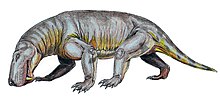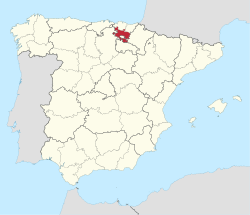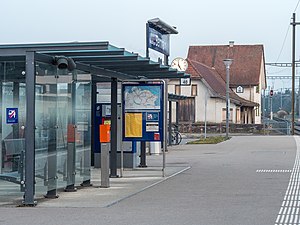루비지아
Rubidgea| 루비지아 시간 범위: 페름기 257–254 엄마 PreꞒ Ꞓ OSDCPTJKPg N↓. | |
|---|---|
 | |
| 해골 Rubidgea atrox의 | |
| 과학적 분류 | |
| 왕국: | 동물계 |
| Phylum: | 코다타 |
| 클래드: | Synapsida |
| 클래드: | Therapsida |
| 클래드: | †고르고놉시아 |
| 가족: | †고르고놉시스과 |
| Tribe: | †루비지니 |
| 지누스: | †루비지아 |
| 모식종 | |
| †루비지아 앳록스 빗자루, 1938년 | |
| 종 | |
| |
| 동의어 해설 | |
| Genus-level
Species-level
| |
gorgonopsid의 남 아프리카와 탄자니아의 상단 Permian에서 Rubidgea은 종의 생존 Rubidgea atrox되어 있다.[1][2] 는 제네릭 이름 Rubidgea 가끔 유명한 카루의 고생물 학자, 교수 브루스 Rubidge 이 연구는 카루 분지의 therapsids를 실시한 대부분에 기여했다의 성에서 발생하는 것으로 생각된다. 하지만, 이 제네릭 이름 실제로 누구였는지 유명한 화석 사냥꾼 Rubidge의 친 할아버지, 시드니 Rubidge를 세워졌다. 그것의 종의 이름은 atrox 라틴어에서 의미“, 야만적이고 끔찍한 치열한”도출한다. 그gorgonopsian 아과 Rubidgeinae, 거대 gorgonopsians은 늦은 페름기(Lopingian)로 제한되어의 파생 그룹의 Rubidgea 일부이다. 그 subfamily Rubidgeinae 처음 Tropidostoma 아쌍블라주 구역에 등장했다. 그들은 보퍼트 그룹 남 아프리카의 Cistecephalus과 Daptocephalus 조립 구역에서 그들의 높은 다양성에 도착했다.[3][4][5]
발견의 역사
첫번째 Rubidgea 화석 C.J.M."Croonie"Kitching, 유명한 고생물 학자 제임스 Kitching의 아버지, 조그만 마을 Nieu-Bethesda 밖에서 1930년대 경에 농장 Doornberg에서 발견되었다. 종이 1938년에 발표된 논문에서 로버트 브룸은 화석 Rubidgea kitchingi.[6] 빗자루가 새로운 종다는 내용의 새로운gorgonopsid 화석의 큰 것으로 지적했다.[7] 그 후 수십년에 마친 뒤 발견, 그리고 Rubidgeinae 세워졌다 빗자루의 의혹은 gorgonopsians의 새 subfamily으로 분류되어야 한다 확인했다.[8]
설명
루비지는 지금까지 살았던 것으로 알려진 가장 큰 고르노프 중 한 명이었다. 표본에서 측정한 결과 성인 루비지의 길이는 최대 46cm(1.51ft)의 두개골을 수용하는 가장 큰 표본인 3.4m(11ft)에 이른 것으로 추정된다. 루비지는 체격이 크고 몸집이 큰 정수리 포식자였으며, 길고 사브르와 같은 송곳니를 가진 두꺼운 두개골을 뽐냈다.[9][10] 루비지나에 집단은 전체적으로 살았다고 알려진 가장 큰 고르노프족으로, 그들의 튼튼한 골격, 특히 두골이 심하게 돌출된 것이 특징적이다. 루비지아 속은 R. atrox, R. plantyrhina, R. majora의[11] 세 종으로 구성되어 있다.
분류

루비지네아과는 아프리카에서만 발견된, 파생된 고르고놉시드의 하위 품종이다. 그들은 6개의 제네라와 17개의 종으로 구성되어 있다. 루비지니아는 러시아에서만 발견된 자매집단인 이노스트란스비니아와 밀접한 관련이 있다. 고르고놉시안 판 중에서 루비지나의 계통이 가장 잘 해결된 것은 독특한 성격적 특성 때문이다. 다른 고르곤opsian 아가족의 체계성은 높은 수준의 taxa 사이의 두개골 동형성으로 인해 혼돈 상태에 머물러 있어 서로 다른 taxa를 효과적으로 구별하기 어렵다.[12][13][14][15][16][17][18][19][20][21] 아래의 클래도그램(Kammerer et al. 2016)은 현재 승인된 고르고놉시아의 체계적 관계를 보여준다.
| 고르고놉시아 |
| |||||||||||||||||||||||||||||||||||||||||||||||||||||||||||||||||||||||||||
상관 관계
루비드게나 고르고놉시드를 포함한 수많은 치료제 종들이 잠비아의 상부 마두마비사 머드스톤 형성과 말라위의 치웨타 침대와 같은 다른 아프리카 바진에서 생물학적 그래프로 사용된다.[22] 루비지아 화석은 탄자니아의 우실리 형성으로부터 복구되었는데, 남아공에서 Permian 시대의 상위 퇴적물과의 생물학적 상관관계를 나타낸다.[23] 아프리카 퇴적물 밖에서 루비지나 화석은 발견되지 않았지만, 이노스탄스바이나 화석은 러시아 화석으로 간주되고 있다.
참조
- ^ Rubidge, Bruce S.; Sidor, Christian A. (2001). "Evolutionary Patterns Among Permo-Triassic Therapsids". Annual Review of Ecology and Systematics. 32 (1): 449–480. doi:10.1146/annurev.ecolsys.32.081501.114113.
- ^ CHINSAMY-TURAN, ANUSUYA (2011-11-18). Forerunners of Mammals: Radiation • Histology • Biology. Indiana University Press. ISBN 9780253005335.
- ^ Lingham-Soliar, Theagarten (2014). "Mammal-Like Reptiles". In Lingham-Soliar, Theagarten (ed.). The Vertebrate Integument Volume 1. The Vertebrate Integument Volume 1: Origin and Evolution. Springer Berlin Heidelberg. pp. 193–219. doi:10.1007/978-3-642-53748-6_8. ISBN 9783642537486.
- ^ Day Michael O.; Ramezani Jahandar; Bowring Samuel A.; Sadler Peter M.; Erwin Douglas H.; Abdala Fernando; Rubidge Bruce S. (2015-07-22). "When and how did the terrestrial mid-Permian mass extinction occur? Evidence from the tetrapod record of the Karoo Basin, South Africa". Proceedings of the Royal Society B: Biological Sciences. 282 (1811): 20150834. doi:10.1098/rspb.2015.0834. PMC 4528552. PMID 26156768.
- ^ Viglietti, P.A.; Smith, R.M.; Angielczyk, K.D.; Kammerer, C.F.; Fröbisch, J.; Rubidge, B.S. (January 2016). "The Daptocephalus Assemblage Zone (Lopingian), South Africa: a proposed biostratigraphy based on a new compilation of stratigraphic ranges". Journal of African Earth Sciences. 113: 153–164. Bibcode:2016JAfES.113..153V. doi:10.1016/j.jafrearsci.2015.10.011.
- ^ 빗자루, 로버트 "20. 남아프리카의 카루오 침대의 새로운 육식 요법 가족에." 런던 동물 학회의 절차에서, 108권, 3번 페이지 527-533. 영국 옥스포드: 블랙웰 출판사, 1938.
- ^ Kitching, J. W. (1953). "Studies on new specimens of the Gorgonopsia".
{{cite journal}}: Cite 저널은 필요로 한다.journal=(도움말) - ^ Cruickshank, A. R. I. (1973). "THE MODE OF LIFE OF GORGONOPSIANS". Palaeontologia Africana : Annals of the Bernard Price Institute for Palaeontological Research. ISSN 0078-8554.
- ^ Jenkins, Ian; Valkenburgh, Blaire Van (2002-10-01). "Evolutionary Patterns in the History of Permo-Triassic and Cenozoic Synapsid Predators". The Paleontological Society Papers. 8: 267–288. doi:10.1017/S1089332600001121. ISSN 1089-3326.
- ^ Kermack, Doris M.; Kermack, Kenneth A. (1984), Kermack, Doris M.; Kermack, Kenneth A. (eds.), "Dentitions, Tooth-Replacement and Jaw Articulation", The Evolution of Mammalian Characters, Springer US, pp. 66–88, doi:10.1007/978-1-4684-7817-4_5, ISBN 9781468478174
- ^ Kammerer, Christian F. (2016-01-26). "Systematics of the Rubidgeinae (Therapsida: Gorgonopsia)". PeerJ. 4: e1608. doi:10.7717/peerj.1608. ISSN 2167-8359. PMC 4730894. PMID 26823998.
- ^ Kemp T. S.; Parrington Francis Rex (1969-09-04). "On the functional morphology of the gorgonopsid skull". Philosophical Transactions of the Royal Society B: Biological Sciences. 256 (801): 1–83. Bibcode:1969RSPTB.256....1K. doi:10.1098/rstb.1969.0036. S2CID 58926603.
- ^ Sigogneau, D. (1968). "On the classification of the Gorgonopsia". Palaeontologia Africana : Annals of the Bernard Price Institute for Palaeontological Research. ISSN 0078-8554.
- ^ Sigogneau-Russell, D.1989년. 테리오돈티아 1: 프히모수치아, 에오티타노슈치아, 고르고놉시아.
- ^ Martins, Rui M. S.; Fröbisch, Jörg; Polcyn, Michael J.; Fernandez, Vincent; Araujo, Ricardo M. (2017-02-21). "Aspects of gorgonopsian paleobiology and evolution: insights from the basicranium, occiput, osseous labyrinth, vasculature, and neuroanatomy". PeerJ. 5: e3119. doi:10.7717/peerj.3119. PMC 5390774. PMID 28413721.
- ^ Norton, Luke Allan (2013-02-01). Relative growth and morphological variation in the skull of Aelurognathus (therapsida: gorgonopsia) (Thesis thesis).
- ^ Gebauer, Eva V. I. (2014), "Re-assessment of the Taxonomic Position of the Specimen GPIT/RE/7113 (Sauroctonus parringtoni comb. nov., Gorgonopsia)", in Kammerer, Christian F.; Angielczyk, Kenneth D.; Fröbisch, Jörg (eds.), Early Evolutionary History of the Synapsida, Vertebrate Paleobiology and Paleoanthropology, Springer Netherlands, pp. 185–207, doi:10.1007/978-94-007-6841-3_12, ISBN 9789400768413
- ^ Kammerer, Christian F. (2014), "A Redescription of Eriphostoma microdon Broom, 1911 (Therapsida, Gorgonopsia) from the Tapinocephalus Assemblage Zone of South Africa and a Review of Middle Permian Gorgonopsians", in Kammerer, Christian F.; Angielczyk, Kenneth D.; Fröbisch, Jörg (eds.), Early Evolutionary History of the Synapsida, Vertebrate Paleobiology and Paleoanthropology, Springer Netherlands, pp. 171–184, doi:10.1007/978-94-007-6841-3_11, ISBN 9789400768413
- ^ Kammerer, Christian F. (2015). "Cranial osteology of Arctognathus curvimola, a short-snouted gorgonopsian from the Late Permian of South Africa". Papers in Palaeontology. 1 (1): 41–58. doi:10.1002/spp2.1002. ISSN 2056-2802.
- ^ Kammerer, Christian F.; Smith, Roger M. H.; Day, Michael O.; Rubidge, Bruce S. (2015). "New information on the morphology and stratigraphic range of the mid-Permian gorgonopsian Eriphostoma microdon Broom, 1911". Papers in Palaeontology. 1 (2): 201–221. doi:10.1002/spp2.1012. ISSN 2056-2802.
- ^ Fröbisch, Jörg; Fernandez, Vincent; Kardjilov, Nikolay; Kammerer, Christian F.; Bendel, Eva-Maria (2018-11-28). "Cranial anatomy of the gorgonopsian Cynariops robustus based on CT-reconstruction". PLOS ONE. 13 (11): e0207367. Bibcode:2018PLoSO..1307367B. doi:10.1371/journal.pone.0207367. ISSN 1932-6203. PMC 6261584. PMID 30485338.
- ^ M.W., 2002년 마이쉬. 카루와 곤드와나 척추동물에 대한 관찰. 제3부: 탄자니아 어퍼페르미안의 고르고노프신들에 대한 주석. Neues Jahrbuch 털 Geologie und Palaontologie-Monatshefte, (4) 페이지 237-251.
- ^ 파링턴, F. R. "동아프리카에서 온 고르고놉시드의 새로운 속" 남아프리카 박물관 64 연보: 47-52.




